Comprehensive Tax Law Analysis: Mary's Residency and Income 2017/2018
VerifiedAdded on 2023/06/07
|5
|1292
|243
Homework Assignment
AI Summary
This assignment provides a comprehensive analysis of Mary's residency status under Australian tax law for the 2017/2018 income year, referencing relevant sections of the Income Tax Assessment Act 1997. It examines the resides test, domicile test, 183-day test, and commonwealth superannuation test to determine her residency. The assignment further assesses whether Mary has a net capital gain, calculating it based on the sale of land and shares, while considering residential dwelling exemptions. Finally, it computes Mary’s taxable income, outlining the reasons for including various income sources and calculating her final tax liability, taking into account her private health insurance. The analysis considers both Australian and London-sourced income, relevant deductions, and the potential impact of double taxation agreements. Desklib offers a wealth of similar solved assignments and past papers for students.
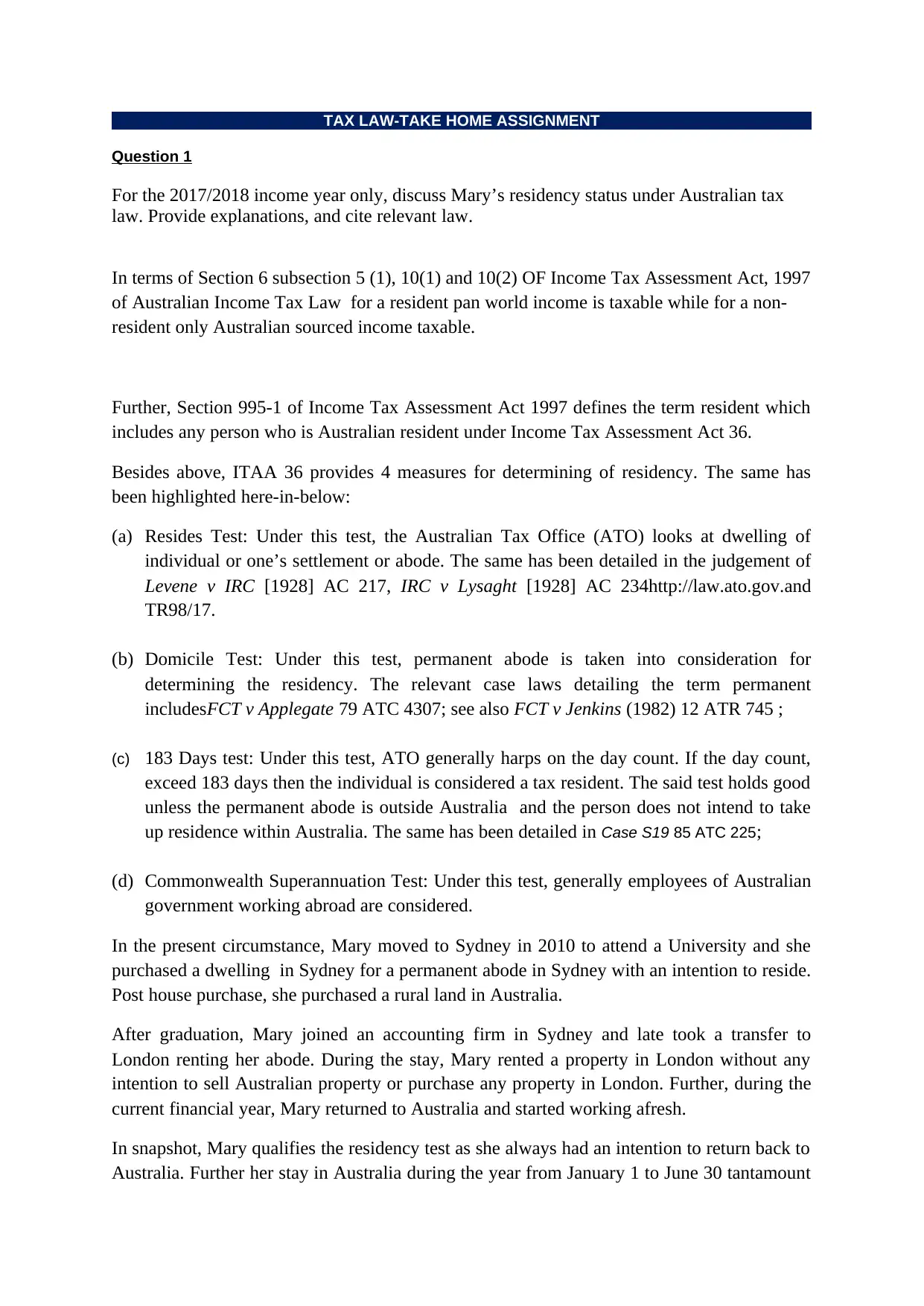
TAX LAW-TAKE HOME ASSIGNMENT
Question 1
For the 2017/2018 income year only, discuss Mary’s residency status under Australian tax
law. Provide explanations, and cite relevant law.
In terms of Section 6 subsection 5 (1), 10(1) and 10(2) OF Income Tax Assessment Act, 1997
of Australian Income Tax Law for a resident pan world income is taxable while for a non-
resident only Australian sourced income taxable.
Further, Section 995-1 of Income Tax Assessment Act 1997 defines the term resident which
includes any person who is Australian resident under Income Tax Assessment Act 36.
Besides above, ITAA 36 provides 4 measures for determining of residency. The same has
been highlighted here-in-below:
(a) Resides Test: Under this test, the Australian Tax Office (ATO) looks at dwelling of
individual or one’s settlement or abode. The same has been detailed in the judgement of
Levene v IRC [1928] AC 217, IRC v Lysaght [1928] AC 234http://law.ato.gov.and
TR98/17.
(b) Domicile Test: Under this test, permanent abode is taken into consideration for
determining the residency. The relevant case laws detailing the term permanent
includesFCT v Applegate 79 ATC 4307; see also FCT v Jenkins (1982) 12 ATR 745 ;
(c) 183 Days test: Under this test, ATO generally harps on the day count. If the day count,
exceed 183 days then the individual is considered a tax resident. The said test holds good
unless the permanent abode is outside Australia and the person does not intend to take
up residence within Australia. The same has been detailed in Case S19 85 ATC 225;
(d) Commonwealth Superannuation Test: Under this test, generally employees of Australian
government working abroad are considered.
In the present circumstance, Mary moved to Sydney in 2010 to attend a University and she
purchased a dwelling in Sydney for a permanent abode in Sydney with an intention to reside.
Post house purchase, she purchased a rural land in Australia.
After graduation, Mary joined an accounting firm in Sydney and late took a transfer to
London renting her abode. During the stay, Mary rented a property in London without any
intention to sell Australian property or purchase any property in London. Further, during the
current financial year, Mary returned to Australia and started working afresh.
In snapshot, Mary qualifies the residency test as she always had an intention to return back to
Australia. Further her stay in Australia during the year from January 1 to June 30 tantamount
Question 1
For the 2017/2018 income year only, discuss Mary’s residency status under Australian tax
law. Provide explanations, and cite relevant law.
In terms of Section 6 subsection 5 (1), 10(1) and 10(2) OF Income Tax Assessment Act, 1997
of Australian Income Tax Law for a resident pan world income is taxable while for a non-
resident only Australian sourced income taxable.
Further, Section 995-1 of Income Tax Assessment Act 1997 defines the term resident which
includes any person who is Australian resident under Income Tax Assessment Act 36.
Besides above, ITAA 36 provides 4 measures for determining of residency. The same has
been highlighted here-in-below:
(a) Resides Test: Under this test, the Australian Tax Office (ATO) looks at dwelling of
individual or one’s settlement or abode. The same has been detailed in the judgement of
Levene v IRC [1928] AC 217, IRC v Lysaght [1928] AC 234http://law.ato.gov.and
TR98/17.
(b) Domicile Test: Under this test, permanent abode is taken into consideration for
determining the residency. The relevant case laws detailing the term permanent
includesFCT v Applegate 79 ATC 4307; see also FCT v Jenkins (1982) 12 ATR 745 ;
(c) 183 Days test: Under this test, ATO generally harps on the day count. If the day count,
exceed 183 days then the individual is considered a tax resident. The said test holds good
unless the permanent abode is outside Australia and the person does not intend to take
up residence within Australia. The same has been detailed in Case S19 85 ATC 225;
(d) Commonwealth Superannuation Test: Under this test, generally employees of Australian
government working abroad are considered.
In the present circumstance, Mary moved to Sydney in 2010 to attend a University and she
purchased a dwelling in Sydney for a permanent abode in Sydney with an intention to reside.
Post house purchase, she purchased a rural land in Australia.
After graduation, Mary joined an accounting firm in Sydney and late took a transfer to
London renting her abode. During the stay, Mary rented a property in London without any
intention to sell Australian property or purchase any property in London. Further, during the
current financial year, Mary returned to Australia and started working afresh.
In snapshot, Mary qualifies the residency test as she always had an intention to return back to
Australia. Further her stay in Australia during the year from January 1 to June 30 tantamount
Paraphrase This Document
Need a fresh take? Get an instant paraphrase of this document with our AI Paraphraser
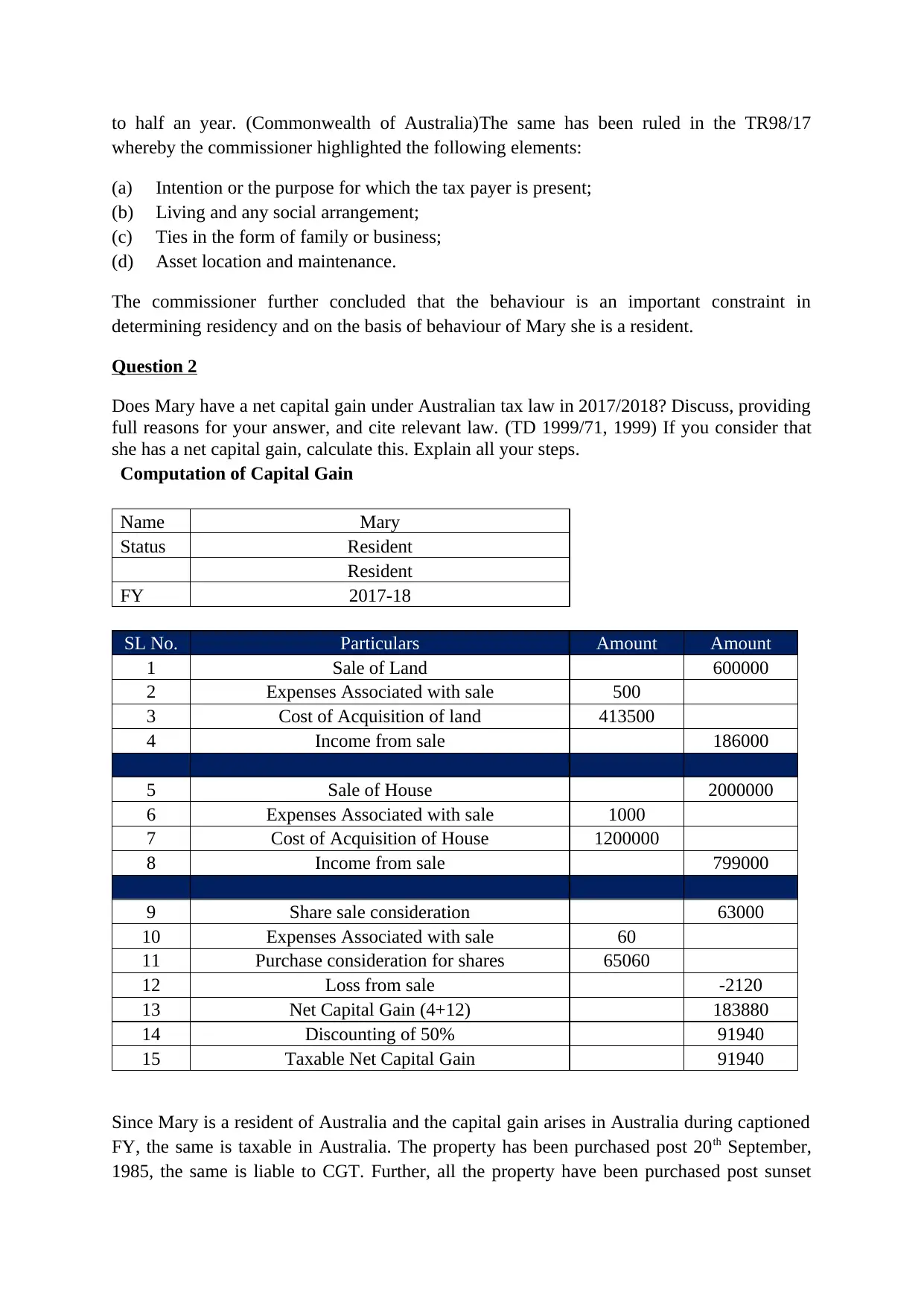
to half an year. (Commonwealth of Australia)The same has been ruled in the TR98/17
whereby the commissioner highlighted the following elements:
(a) Intention or the purpose for which the tax payer is present;
(b) Living and any social arrangement;
(c) Ties in the form of family or business;
(d) Asset location and maintenance.
The commissioner further concluded that the behaviour is an important constraint in
determining residency and on the basis of behaviour of Mary she is a resident.
Question 2
Does Mary have a net capital gain under Australian tax law in 2017/2018? Discuss, providing
full reasons for your answer, and cite relevant law. (TD 1999/71, 1999) If you consider that
she has a net capital gain, calculate this. Explain all your steps.
Computation of Capital Gain
Name Mary
Status Resident
Resident
FY 2017-18
SL No. Particulars Amount Amount
1 Sale of Land 600000
2 Expenses Associated with sale 500
3 Cost of Acquisition of land 413500
4 Income from sale 186000
5 Sale of House 2000000
6 Expenses Associated with sale 1000
7 Cost of Acquisition of House 1200000
8 Income from sale 799000
9 Share sale consideration 63000
10 Expenses Associated with sale 60
11 Purchase consideration for shares 65060
12 Loss from sale -2120
13 Net Capital Gain (4+12) 183880
14 Discounting of 50% 91940
15 Taxable Net Capital Gain 91940
Since Mary is a resident of Australia and the capital gain arises in Australia during captioned
FY, the same is taxable in Australia. The property has been purchased post 20th September,
1985, the same is liable to CGT. Further, all the property have been purchased post sunset
whereby the commissioner highlighted the following elements:
(a) Intention or the purpose for which the tax payer is present;
(b) Living and any social arrangement;
(c) Ties in the form of family or business;
(d) Asset location and maintenance.
The commissioner further concluded that the behaviour is an important constraint in
determining residency and on the basis of behaviour of Mary she is a resident.
Question 2
Does Mary have a net capital gain under Australian tax law in 2017/2018? Discuss, providing
full reasons for your answer, and cite relevant law. (TD 1999/71, 1999) If you consider that
she has a net capital gain, calculate this. Explain all your steps.
Computation of Capital Gain
Name Mary
Status Resident
Resident
FY 2017-18
SL No. Particulars Amount Amount
1 Sale of Land 600000
2 Expenses Associated with sale 500
3 Cost of Acquisition of land 413500
4 Income from sale 186000
5 Sale of House 2000000
6 Expenses Associated with sale 1000
7 Cost of Acquisition of House 1200000
8 Income from sale 799000
9 Share sale consideration 63000
10 Expenses Associated with sale 60
11 Purchase consideration for shares 65060
12 Loss from sale -2120
13 Net Capital Gain (4+12) 183880
14 Discounting of 50% 91940
15 Taxable Net Capital Gain 91940
Since Mary is a resident of Australia and the capital gain arises in Australia during captioned
FY, the same is taxable in Australia. The property has been purchased post 20th September,
1985, the same is liable to CGT. Further, all the property have been purchased post sunset
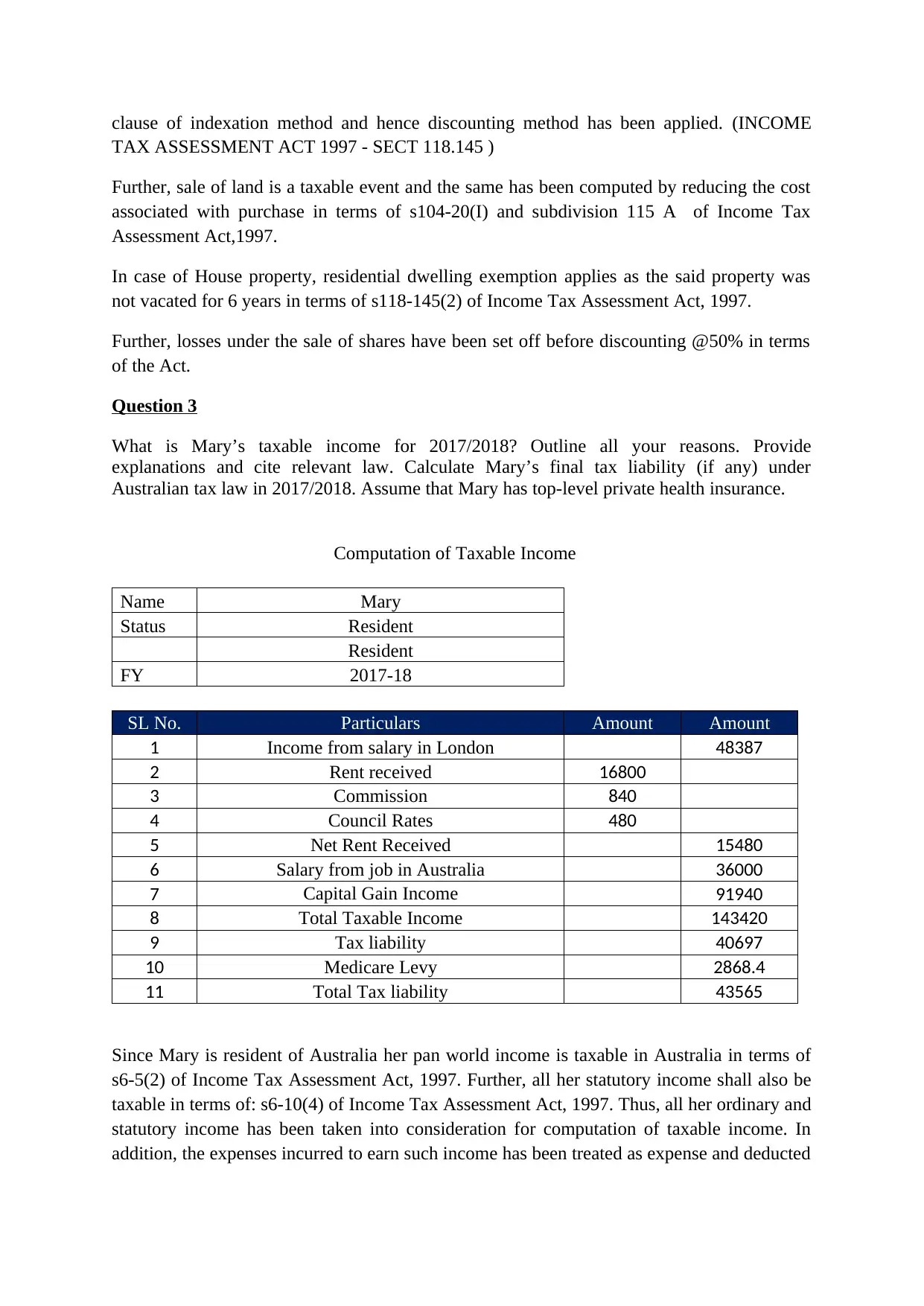
clause of indexation method and hence discounting method has been applied. (INCOME
TAX ASSESSMENT ACT 1997 - SECT 118.145 )
Further, sale of land is a taxable event and the same has been computed by reducing the cost
associated with purchase in terms of s104-20(I) and subdivision 115 A of Income Tax
Assessment Act,1997.
In case of House property, residential dwelling exemption applies as the said property was
not vacated for 6 years in terms of s118-145(2) of Income Tax Assessment Act, 1997.
Further, losses under the sale of shares have been set off before discounting @50% in terms
of the Act.
Question 3
What is Mary’s taxable income for 2017/2018? Outline all your reasons. Provide
explanations and cite relevant law. Calculate Mary’s final tax liability (if any) under
Australian tax law in 2017/2018. Assume that Mary has top-level private health insurance.
Computation of Taxable Income
Name Mary
Status Resident
Resident
FY 2017-18
SL No. Particulars Amount Amount
1 Income from salary in London 48387
2 Rent received 16800
3 Commission 840
4 Council Rates 480
5 Net Rent Received 15480
6 Salary from job in Australia 36000
7 Capital Gain Income 91940
8 Total Taxable Income 143420
9 Tax liability 40697
10 Medicare Levy 2868.4
11 Total Tax liability 43565
Since Mary is resident of Australia her pan world income is taxable in Australia in terms of
s6-5(2) of Income Tax Assessment Act, 1997. Further, all her statutory income shall also be
taxable in terms of: s6-10(4) of Income Tax Assessment Act, 1997. Thus, all her ordinary and
statutory income has been taken into consideration for computation of taxable income. In
addition, the expenses incurred to earn such income has been treated as expense and deducted
TAX ASSESSMENT ACT 1997 - SECT 118.145 )
Further, sale of land is a taxable event and the same has been computed by reducing the cost
associated with purchase in terms of s104-20(I) and subdivision 115 A of Income Tax
Assessment Act,1997.
In case of House property, residential dwelling exemption applies as the said property was
not vacated for 6 years in terms of s118-145(2) of Income Tax Assessment Act, 1997.
Further, losses under the sale of shares have been set off before discounting @50% in terms
of the Act.
Question 3
What is Mary’s taxable income for 2017/2018? Outline all your reasons. Provide
explanations and cite relevant law. Calculate Mary’s final tax liability (if any) under
Australian tax law in 2017/2018. Assume that Mary has top-level private health insurance.
Computation of Taxable Income
Name Mary
Status Resident
Resident
FY 2017-18
SL No. Particulars Amount Amount
1 Income from salary in London 48387
2 Rent received 16800
3 Commission 840
4 Council Rates 480
5 Net Rent Received 15480
6 Salary from job in Australia 36000
7 Capital Gain Income 91940
8 Total Taxable Income 143420
9 Tax liability 40697
10 Medicare Levy 2868.4
11 Total Tax liability 43565
Since Mary is resident of Australia her pan world income is taxable in Australia in terms of
s6-5(2) of Income Tax Assessment Act, 1997. Further, all her statutory income shall also be
taxable in terms of: s6-10(4) of Income Tax Assessment Act, 1997. Thus, all her ordinary and
statutory income has been taken into consideration for computation of taxable income. In
addition, the expenses incurred to earn such income has been treated as expense and deducted
⊘ This is a preview!⊘
Do you want full access?
Subscribe today to unlock all pages.

Trusted by 1+ million students worldwide
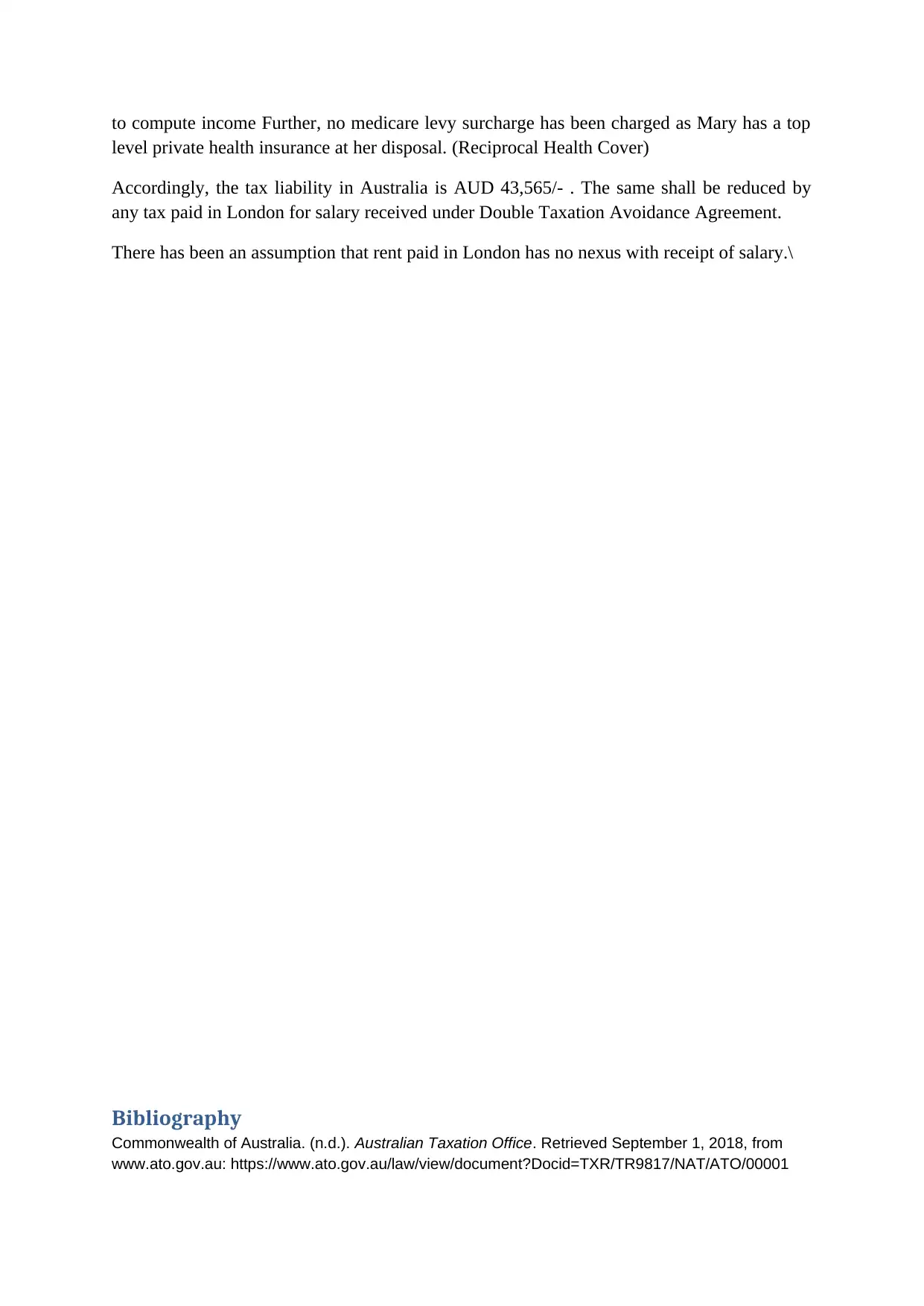
to compute income Further, no medicare levy surcharge has been charged as Mary has a top
level private health insurance at her disposal. (Reciprocal Health Cover)
Accordingly, the tax liability in Australia is AUD 43,565/- . The same shall be reduced by
any tax paid in London for salary received under Double Taxation Avoidance Agreement.
There has been an assumption that rent paid in London has no nexus with receipt of salary.\
Bibliography
Commonwealth of Australia. (n.d.). Australian Taxation Office. Retrieved September 1, 2018, from
www.ato.gov.au: https://www.ato.gov.au/law/view/document?Docid=TXR/TR9817/NAT/ATO/00001
level private health insurance at her disposal. (Reciprocal Health Cover)
Accordingly, the tax liability in Australia is AUD 43,565/- . The same shall be reduced by
any tax paid in London for salary received under Double Taxation Avoidance Agreement.
There has been an assumption that rent paid in London has no nexus with receipt of salary.\
Bibliography
Commonwealth of Australia. (n.d.). Australian Taxation Office. Retrieved September 1, 2018, from
www.ato.gov.au: https://www.ato.gov.au/law/view/document?Docid=TXR/TR9817/NAT/ATO/00001
Paraphrase This Document
Need a fresh take? Get an instant paraphrase of this document with our AI Paraphraser
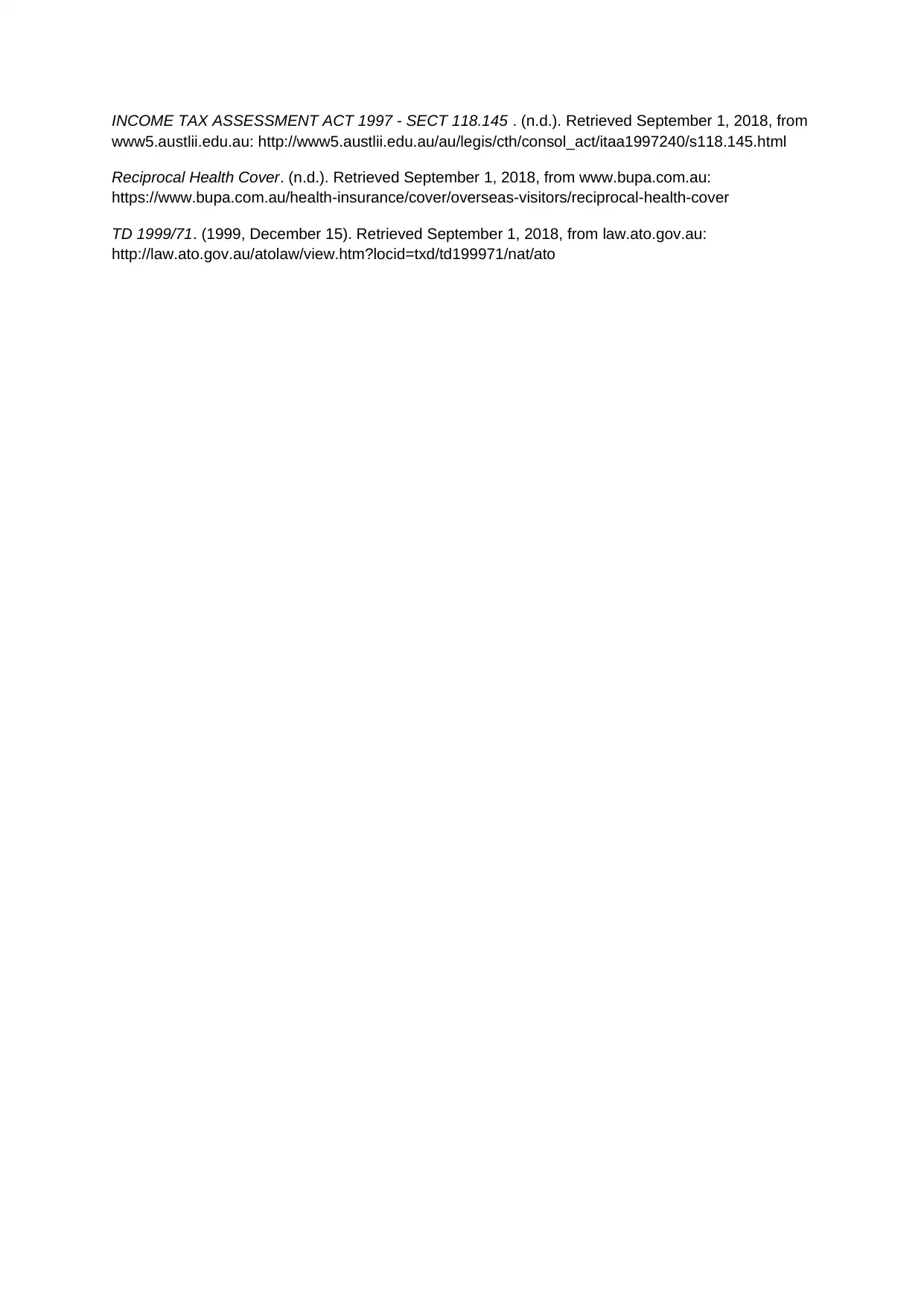
INCOME TAX ASSESSMENT ACT 1997 - SECT 118.145 . (n.d.). Retrieved September 1, 2018, from
www5.austlii.edu.au: http://www5.austlii.edu.au/au/legis/cth/consol_act/itaa1997240/s118.145.html
Reciprocal Health Cover. (n.d.). Retrieved September 1, 2018, from www.bupa.com.au:
https://www.bupa.com.au/health-insurance/cover/overseas-visitors/reciprocal-health-cover
TD 1999/71. (1999, December 15). Retrieved September 1, 2018, from law.ato.gov.au:
http://law.ato.gov.au/atolaw/view.htm?locid=txd/td199971/nat/ato
www5.austlii.edu.au: http://www5.austlii.edu.au/au/legis/cth/consol_act/itaa1997240/s118.145.html
Reciprocal Health Cover. (n.d.). Retrieved September 1, 2018, from www.bupa.com.au:
https://www.bupa.com.au/health-insurance/cover/overseas-visitors/reciprocal-health-cover
TD 1999/71. (1999, December 15). Retrieved September 1, 2018, from law.ato.gov.au:
http://law.ato.gov.au/atolaw/view.htm?locid=txd/td199971/nat/ato
1 out of 5
Related Documents
Your All-in-One AI-Powered Toolkit for Academic Success.
+13062052269
info@desklib.com
Available 24*7 on WhatsApp / Email
![[object Object]](/_next/static/media/star-bottom.7253800d.svg)
Unlock your academic potential
Copyright © 2020–2025 A2Z Services. All Rights Reserved. Developed and managed by ZUCOL.





